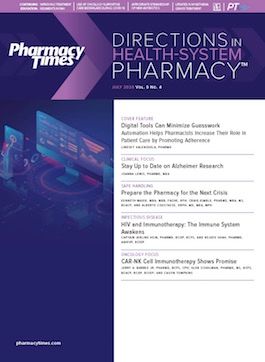Publication
Article
Pharmacy Practice in Focus: Health Systems
Updates for Influenza Vaccination Recommendations: Role of the Pharmacist
Author(s):
The 2020 virtual Directions in Pharmacy® conference provided a comprehensive overview of influenza, including identifying at-risk patients and providing interventions to address vaccination misconceptions.
Influenza disease prevention, identification, and vaccination was a topic discussed during the 2020 virtual Directions in Pharmacy® conference. Rupal Mansukhani, PharmD, FAPhA, CTTS, presented a comprehensive overview of influenza disease, including identifying at-risk patient populations, analyzing safety and efficacy data for vaccine preparations, and providing interventions to address influenza vaccination misconceptions.
Dr Mansukhani began the discussion by covering all aspects of influenza. Influenza is a contagious respiratory illness that is transmitted via droplets and can result in mild to severe illness and even death. Most illness within humans is caused by influenza A and B, which is reflected in the composition of the yearly influenza vaccine (2 A strains and 2 B strains). She then went on to review the Healthy People 2020 Initiative, which was launched in 2010 and includes specific vaccination goals for influenza.
The surveillance of influenza-like illness and confirmed laboratory tests were examined, with notably high years during the 2009-2010 (H1N1) and 2017-2018 (H3N2) seasons. Dr Mansukhani explained that the burden of disease varies from year to year; still, the lowest estimate includes 9.3 million illnesses, 140,000 hospitalizations, and 12,000 deaths.
She then transitioned the discussion to the importance of influenza vaccination. The overall vaccine efficacy (VE) for influenza is 45%, with 50% for influenza B and 37% against influenza A (H1N1). Influenza VE varies from season to season; however, vaccination can help decrease the severity of disease. Specific patient populations that are at higher risk for influenza-related complications (eg, pneumonia, multi-organ failure) include those with chronic conditions and those who are immunocompromised or pregnant (not all-inclusive). Further, although most patients recover within a few days to less than 2 weeks, unfortunately, many patients succumb to their illness.
Because of the risk of mortality, in 2019 the CDC and the American Committee on Immunization Practices (ACIP) recommended that influenza vaccination be offered by the end of October before influenza activity begins in the community. Dr Mansukhani thoroughly went over the different types of vaccines available. However, no trivalent regular-dose influenza vaccines were available as of 2019. Instead, they were replaced with quadrivalent regular-dose and recombinant vaccines. High-dose and adjuvanted trivalent vaccines were also available for patients 65 years of age and older. These vaccines licensed for older patients are intended to elicit a better immune response compared to the standard dose. Dr Mansukhani also provided safety and efficacy data for each preparation, including recommendations for age, dosing, and contraindications.
Dr Mansukhani finished the discussion with strategies pharmacists can use to address misconceptions about influenza vaccines; some common misbeliefs to pay attention to are that influenza shots make patients sick and that they are not recommended in pregnancy. She emphasized the importance of open communication with strong recommendations for vaccination. Addressing vaccine-related concerns with open dialogue is crucial for building trust and increasing patient acceptance, especially among those who are hesitant. As a closing point, Dr Mansukhani reminded the audience that to increase acceptance, it is important to highlight positives (eg, number of lives saved) versus negatives (ie, deaths) when providing counseling to patients and to address the patient’s misconceptions and concerns.
RUPAL MANSUKHANI, PharmD, FAPhA, CTTS, is a clinical associate professor at the Ernest Mario School of Pharmacy at Rutgers University. She completed her Doctor of Pharmacy degree in 2004 at the Philadelphia College of Pharmacy. Upon graduation, she completed a PGY-1 Community Practice Residency at the University of Illinois in Chicago. Until 2012, she worked in community practice at Pathmark Pharmacy, where she taught students about clinical outpatient services. She currently practices at Morristown Medical Center in transitions of care. Her areas of interest include respiratory conditions, such as chronic obstructive pulmonary disease, asthma, and pneumonia, with a special interest in advancing immunization rates. Advancing patient care and promoting pharmacy through research, scholarly activities, and presentations have also been fundamental to Dr Mansukhani’s approach to moving the profession of pharmacy forward. She has presented her research at local, regional, national, and international meetings. She is passionate about teaching and continues to improve immunization rates within her state.







